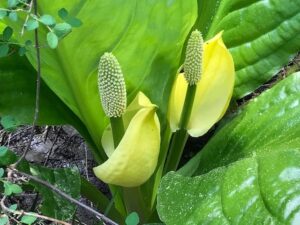— Peter Guillozet, Orcas Island Preserve Steward
 This time of year skunk cabbage or swamp lantern (Lysichiton americanus) can appear as a burst of color in the otherwise shadowy understory of cedar-dominated island wetlands. Its bright yellow hood (spathe) and central stalk (spadix) emit a distinctive skunk-like odor that attracts pollinating flies and beetles. At certain times, chemical reactions in these flowers can produce temperatures of up to 70 degrees, and individual plants live an estimated 20 years.
This time of year skunk cabbage or swamp lantern (Lysichiton americanus) can appear as a burst of color in the otherwise shadowy understory of cedar-dominated island wetlands. Its bright yellow hood (spathe) and central stalk (spadix) emit a distinctive skunk-like odor that attracts pollinating flies and beetles. At certain times, chemical reactions in these flowers can produce temperatures of up to 70 degrees, and individual plants live an estimated 20 years.
Related to other Arums such as calla lilies and taro root, skunk cabbage is one of the few members of the Araceae family native to the Pacific Northwest and can be found in bogs and swamps and along shaded streams and lakeshores from northern California to the Aleutian Islands and inland to the Rocky Mountains. A close relative grows across much of eastern North America. As with taro in the tropics, Indigenous people throughout our region roasted skunk cabbage roots to neutralize high levels of oxalic acid. The large leaves were used as well to line berry baskets and to wrap food in steaming pits. Although some sources suggest that skunk cabbage was seen as famine food prior to the arrival of spring salmon, others report that it was eaten throughout the year. Skunk cabbage leaves should never be eaten raw, but conditions such as burns and boils were once treated with poultices made from leaves and roots. Skunk cabbage roots are also eaten by elk, bear, muskrats, and other animals.

